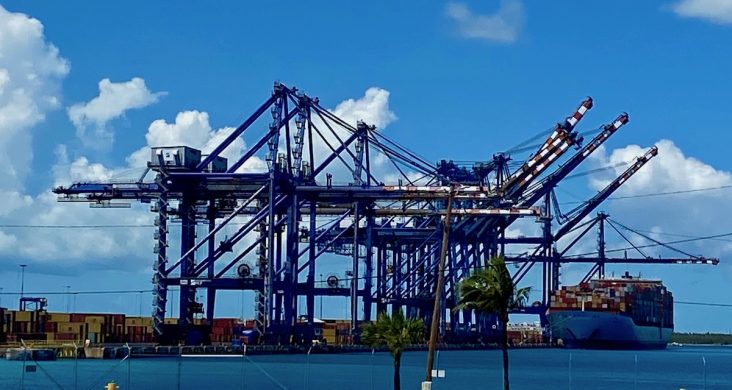Port congestion expected to ease amid slower imports by year end
by August 9, 2022 3:03 pm 1,531 views

A cargo ship sits at the Port of New Orleans.
Port congestion has been a major challenge for retailers in the past 18 months. But after a record-setting spring, imports at the largest U.S. ports are expected to slow for the remainder of the year, according to the National Retail Federation (NRF) and Hackett Associates.
The latest report from Hackett suggests that although retail sales are still growing, the economy is slowing and that is reflected in cargo shipments. The NRF warns while congestion may be eased there are still challenges ahead.
“Lower volumes may help ease congestion at some ports, but others are still seeing backups and global supply chain challenges are far from over,” said Jonathan Gold, NRF vice president for supply chain and customs policy.
Gold said the biggest concern is the potential for disruption because of separate labor negotiations at the West Coast ports and the freight railroads. He said concluding both sets of negotiations without disruption is critical as the holiday season approaches. He also said the contract between the International Longshore and Warehouse Union and the Pacific Maritime Association expired July 1. Many retailers like Walmart and Home Depot brought in cargo early and shifted to East and Gulf Coast ports to avoid any potential disruptions related to contract negotiations, with early shipments helping drive second-quarter volumes.
Hackett said freight railroads and their unions are working with a Presidential Emergency Board to resolve contract discussions, which have been ongoing for two years. In addition, the Port of Oakland was briefly closed in late July amid protests by independent truckers over a new state law aimed at eliminating independent owner-operators.
“The heady days of growth in imports are quickly receding,” said Hackett Associates founder Ben Hackett. “The outlook is for a decline in volumes compared with 2021 over the next few months, and the decline is expected to deepen in 2023.”
The report found U.S. ports handled 2.25 million TEU (20-foot containers) in June, the latest month for which data is available. Import volume was down 5.9% from May’s 2.4 million TEU – the largest number of containers imported in a single month since NRF began tracking imports in 2002. June’s results brought the first half of the year to 13.5 million TEU, a 5.5% increase year over year. Container unit volume was up 3.2% year over year in June.
Ports have not yet reported July’s numbers, but Hackett projected the month at 2.26 million TEU, up 3.2% year over year. The August forecast is 2.2 million containers down 3%. Volume is expected to slow to 2.15 million containers by September and 2.13 million containers by October. Hackett predict by December container volume coming into U.S. ports will be 2.03 million, down 3% from a year ago.
Hackett said if the forecasts hold true that would bring import volume for the second half of 2022 to 12.8 million containers, down 1.5% from year-ago period. That said, a strong first half would increase container import volume to 26.3 million TEU, up 2% from the last year’s record 25.8 million containers.
Despite recession fears, the NRF forecasts 2022 retail sales will grow from 6% to 8% over last year. For the first half of 2022, retail sales rose 7% year over year, the trade group reported. NRF recently lowered its GDP predictions for the back half of the year from 3.5% to 2%. NRF said container volume may be slowing from unprecedented highs relating to the pandemic demand, but the U.S. economy does not appear to in a recession even through the two recent quarters of negative GDP.
“Back-to-back contractions have heightened fear of a recession, but while the economy has lost momentum heading into the second half of the year, economic data is not yet consistent with a typical recession,” said Jack Kleinhenz, NRF chief economist. “Our view is that while the economy is functioning at a slower pace it is likely to avoid a recession this year. Despite ongoing uncertainties, we believe the underlying strength of the economy is strong enough to deal with inflation and keep a recession at bay – or short-lived even if we are wrong.”
Kleinhenz said even with two quarters of GDP decline, private final sales to domestic purchasers – a key measurement of both consumer and business spending – remained in positive territory for the first half of the year, up 3% in the first quarter and flat in the second. He said other indicators including employment, retail sales, income and industrial production have seen slower growth, but none have contracted. He said as long as people are employed, spending will continue. Retail sales as defined by NRF – excluding automobile dealers, gasoline stations and restaurants to focus on core retail – were up 7% year over year in the first six months of the year.
